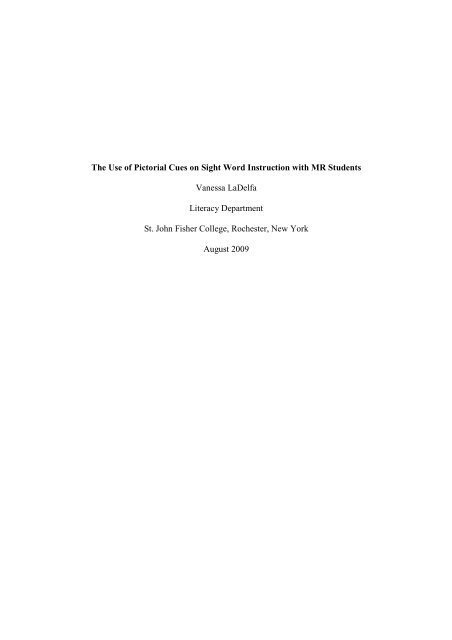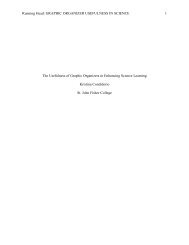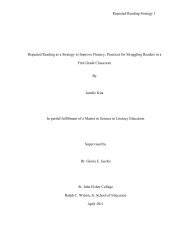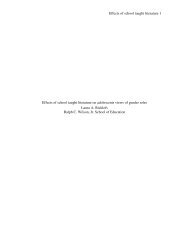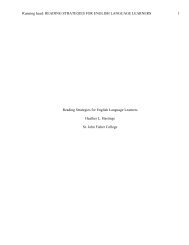The Use of Pictorial Cues on Sight word Instruction with MR Students
The Use of Pictorial Cues on Sight word Instruction with MR Students
The Use of Pictorial Cues on Sight word Instruction with MR Students
Create successful ePaper yourself
Turn your PDF publications into a flip-book with our unique Google optimized e-Paper software.
<str<strong>on</strong>g>The</str<strong>on</strong>g> <str<strong>on</strong>g>Use</str<strong>on</strong>g> <str<strong>on</strong>g>of</str<strong>on</strong>g> <str<strong>on</strong>g>Pictorial</str<strong>on</strong>g> <str<strong>on</strong>g>Cues</str<strong>on</strong>g> <strong>on</strong> <strong>Sight</strong> Word Instructi<strong>on</strong> <strong>with</strong> <strong>MR</strong> <strong>Students</strong><br />
Vanessa LaDelfa<br />
Literacy Department<br />
St. John Fisher College, Rochester, New York<br />
August 2009
<strong>Sight</strong> Word Instructi<strong>on</strong> <strong>with</strong> <strong>Students</strong> <strong>with</strong> <strong>MR</strong> 2<br />
Abstract<br />
In today’s fast paced society, literacy is an essential skill. It is imperative that<br />
educators provide effective literacy acquisiti<strong>on</strong> to all students; teachers need to alter their<br />
educati<strong>on</strong> strategies to better fit students’ individual needs, especially those <strong>with</strong><br />
disabilities. <strong>Sight</strong> <strong>word</strong> recogniti<strong>on</strong> is a critical emergent literacy skill, especially for<br />
`those <strong>with</strong> multiple disabilities (Alant, Lloyd, & Van der Bijl, 2006; Burns, 2007;<br />
Didden, Graff, Nelemans, Lanci<strong>on</strong>i, & Vooren, 2006). <strong>Sight</strong> <strong>word</strong> instructi<strong>on</strong> is<br />
traditi<strong>on</strong>ally taught using <strong>word</strong> <strong>on</strong>ly skill and drill approach. However there have been<br />
recent studies <str<strong>on</strong>g>of</str<strong>on</strong>g> the impact <str<strong>on</strong>g>of</str<strong>on</strong>g> integrating pictures during sight <strong>word</strong> instructi<strong>on</strong>.<br />
<str<strong>on</strong>g>The</str<strong>on</strong>g>refore, I proposed the questi<strong>on</strong>: How does the use <str<strong>on</strong>g>of</str<strong>on</strong>g> pictorial cues impact sight <strong>word</strong><br />
instructi<strong>on</strong> <strong>with</strong> students <strong>with</strong> <strong>MR</strong>? I c<strong>on</strong>ducted a three m<strong>on</strong>th study using different<br />
instructi<strong>on</strong>al strategies to help discover my answer.<br />
Literacy is a crucial skill needed to be socially accepted in today’s society. Those<br />
who are illiterate are c<strong>on</strong>sidered to be a failure or deviant. This populati<strong>on</strong> experiences a<br />
life-sentence <str<strong>on</strong>g>of</str<strong>on</strong>g> reduced opportunity and restricted choices (Kliewer, & Landis, 1999).<br />
<str<strong>on</strong>g>The</str<strong>on</strong>g>refore, it is imperative that educators provide effective literacy acquisiti<strong>on</strong> to all<br />
students. Teachers need to alter their educati<strong>on</strong> strategies to better fit students’<br />
individual needs, especially those <strong>with</strong> disabilities.<br />
<strong>Sight</strong> <strong>word</strong>s are an essential emergent literacy skill in reading acquisiti<strong>on</strong> for<br />
children, especially children <strong>with</strong> multiple disabilities (Alant, Lloyd, & Van der Bijl,<br />
2006; Burns, 2007; Didden, Graff, Nelemans, Lanci<strong>on</strong>i, & Vooren, 2006). Burns (2007)
<strong>Sight</strong> Word Instructi<strong>on</strong> <strong>with</strong> <strong>Students</strong> <strong>with</strong> <strong>MR</strong> 3<br />
states that sight <strong>word</strong> instructi<strong>on</strong> provides a “comprehensive foundati<strong>on</strong> for functi<strong>on</strong>al<br />
academics” for those <strong>with</strong> disabilities because it improves their ability to do every day<br />
jobs such as: daily, recreati<strong>on</strong>al, and work-related tasks. Educators main goal is to<br />
provide effective literacy acquisiti<strong>on</strong> to all students therefore, researchers have d<strong>on</strong>e<br />
studies to discover the best approach to sight <strong>word</strong> instructi<strong>on</strong>. Researchers have found<br />
the integrati<strong>on</strong> <str<strong>on</strong>g>of</str<strong>on</strong>g> pictorial cues and fading pictorial prompts useful to sight <strong>word</strong><br />
instructi<strong>on</strong> (C<strong>on</strong>ners, Kiser, Rosenquist, & Sligh, 2006). <str<strong>on</strong>g>The</str<strong>on</strong>g>refore, the questi<strong>on</strong> at hand<br />
that needs to be answered is and how is the use <str<strong>on</strong>g>of</str<strong>on</strong>g> pictorial cues during sight <strong>word</strong><br />
instructi<strong>on</strong> beneficial to students <strong>with</strong> <strong>MR</strong>?<br />
I c<strong>on</strong>ducted a study to discover the answer to my questi<strong>on</strong>. <str<strong>on</strong>g>The</str<strong>on</strong>g> study c<strong>on</strong>sisted <str<strong>on</strong>g>of</str<strong>on</strong>g><br />
three m<strong>on</strong>ths. Each m<strong>on</strong>th, I incorporated a different sight <strong>word</strong> instructi<strong>on</strong>al approach<br />
(pictorial cues, fading pictorial cues, and <strong>word</strong> <strong>on</strong>ly). Assessments were given at the end<br />
<str<strong>on</strong>g>of</str<strong>on</strong>g> each week throughout the study. After evaluating the assessments, sight <strong>word</strong><br />
instructi<strong>on</strong> <strong>with</strong> fading pictorial cues proved to be the most beneficial to students <strong>with</strong><br />
<strong>MR</strong>.<br />
<str<strong>on</strong>g>The</str<strong>on</strong>g>oretical Framework<br />
“Literacy is primarily something people do; it is an activity, located in the space<br />
between thought and text. Literacy does not just reside in people’s heads as a set <str<strong>on</strong>g>of</str<strong>on</strong>g> skills<br />
to be learned, and it does not just reside <strong>on</strong> paper, captured as texts to be analyzed. Like<br />
all human activity, literacy is essentially social, and it is located in the interacti<strong>on</strong><br />
between people” (Bart<strong>on</strong> & Hamilt<strong>on</strong> 1998; taken from Lars<strong>on</strong> & Marsh, 2005, p. 10).<br />
Being socially accepted am<strong>on</strong>g cultures is what makes literacy a factor that encompasses<br />
the aspects <strong>with</strong>in <strong>on</strong>e’s life. <strong>Students</strong> that fail in classroom reading is <str<strong>on</strong>g>of</str<strong>on</strong>g>ten c<strong>on</strong>sidered
<strong>Sight</strong> Word Instructi<strong>on</strong> <strong>with</strong> <strong>Students</strong> <strong>with</strong> <strong>MR</strong> 4<br />
to be equal <strong>with</strong> school failure and a life-sentence <str<strong>on</strong>g>of</str<strong>on</strong>g> reduced opportunity and restricted<br />
choices (Kliewer, & Landis, 1999). <str<strong>on</strong>g>The</str<strong>on</strong>g>y are suggested to be deviant because they lack<br />
literacy (Ong, 1986). <strong>Students</strong> <strong>with</strong> special needs are <str<strong>on</strong>g>of</str<strong>on</strong>g>ten excluded from the literacy<br />
community or become a decidedly delimited participant. <str<strong>on</strong>g>The</str<strong>on</strong>g>refore, teachers must see<br />
all children as symbolic and potentially literate, including children <strong>with</strong> severe<br />
intellectual disabilities, and support the child as necessary in order to c<strong>on</strong>nect him or her<br />
to the surrounding classroom’s literate community (Kliewer, & Landis, 1999).<br />
“Children develop noti<strong>on</strong>s about literacy in the same way that they develop other<br />
significant learning’s: That is, children discover and invent literacy as they participate<br />
actively in a literate society” (Goodman, 1984, p.316). At birth humans are immediately<br />
immersed in a literate enriched society. Society serves as a model <str<strong>on</strong>g>of</str<strong>on</strong>g> literacy. <str<strong>on</strong>g>The</str<strong>on</strong>g>se new<br />
members interact and learn skills dem<strong>on</strong>strated by their role models (Goodman, 1984).<br />
Learners develop language knowledge through data, collecti<strong>on</strong>, rule generati<strong>on</strong>, rule<br />
testing, and rule modificati<strong>on</strong> based <strong>on</strong> their communicative experiences at home or in<br />
the classroom (Kucer, 2005). Children then c<strong>on</strong>struct the dimensi<strong>on</strong>s <str<strong>on</strong>g>of</str<strong>on</strong>g> language <strong>with</strong><br />
this data. New hypothesizes are created for every language encounter children have;<br />
therefore, the more language encounters equal more new hypothesizes about the literacy<br />
system (Kucer, 2005). As time passes, Children’s attempts at using language become<br />
more and more c<strong>on</strong>venti<strong>on</strong>al. <str<strong>on</strong>g>The</str<strong>on</strong>g>ir hypothesis leads to mistakes from which they learn<br />
proper language patterns. This course <str<strong>on</strong>g>of</str<strong>on</strong>g> acti<strong>on</strong> is referred to as a Recursive Process<br />
(Kucer, 2005). In this stage, children actively try to understand how language operates<br />
and generate a list <str<strong>on</strong>g>of</str<strong>on</strong>g> rules. Frequently, their rules are over generalized because children
<strong>Sight</strong> Word Instructi<strong>on</strong> <strong>with</strong> <strong>Students</strong> <strong>with</strong> <strong>MR</strong> 5<br />
are not aware <str<strong>on</strong>g>of</str<strong>on</strong>g> the excepti<strong>on</strong>s. For example, a child learns the /ed/ rule for past tense.<br />
At this stage, the child uses this rule <strong>on</strong> every <strong>word</strong> making go, goed and am, amed.<br />
<str<strong>on</strong>g>The</str<strong>on</strong>g>se stages <str<strong>on</strong>g>of</str<strong>on</strong>g> development do not progress at the same rate for every child,<br />
some develop faster and some slower. <str<strong>on</strong>g>The</str<strong>on</strong>g>refore, it is crucial for educators to provide<br />
literacy instructi<strong>on</strong> based <strong>on</strong> students’ individual development level rather than age or<br />
grade level (; C<strong>on</strong>ners, Kiser, Rosenquist, & Sligh, 2006; Carr, Hedrick, & Katims, 1999;<br />
Jobling, M<strong>on</strong>i, & Morgan, 2006; Kliewer, & Landis, 1999). Research indicates that the<br />
preventi<strong>on</strong> <str<strong>on</strong>g>of</str<strong>on</strong>g> reading failure begins in preschool, especially for those <strong>with</strong> slower<br />
development, when children are learning critical emerging literacy skills for reading<br />
success including ph<strong>on</strong>ological awareness, print awareness, letter recogniti<strong>on</strong> and early<br />
writing skills (Hawken, Johnst<strong>on</strong>, & McD<strong>on</strong>nell, 2008). Research has proven students<br />
increased their reading and writing behaviors 3 to 10 times <strong>with</strong> the use <str<strong>on</strong>g>of</str<strong>on</strong>g> a literacy- rich<br />
envir<strong>on</strong>ment (Hawken, Johnst<strong>on</strong>, & McD<strong>on</strong>nell, 2008).<br />
School curriculums are based <strong>on</strong> Standard English and standard rate <str<strong>on</strong>g>of</str<strong>on</strong>g><br />
development. Habitually, feelings <str<strong>on</strong>g>of</str<strong>on</strong>g> frustrati<strong>on</strong> stemming from differences in self and<br />
acceptable dialect give rise to negative feelings toward literacy acquisiti<strong>on</strong> to students<br />
<strong>with</strong> disabilities. <str<strong>on</strong>g>The</str<strong>on</strong>g>se students either drop-out <str<strong>on</strong>g>of</str<strong>on</strong>g> school or decide to not-learn.<br />
Teachers resolve not-learning through not-teaching (Delpit, 1995). Unfortunately, the<br />
literacy instructi<strong>on</strong> for students’ <strong>with</strong> disabilities emphasizes living skills more than<br />
literacy skills, creating illiterate members <str<strong>on</strong>g>of</str<strong>on</strong>g> society (Jobling, M<strong>on</strong>i, & Morgan, 2006).<br />
To provide effective literacy acquisiti<strong>on</strong> to all students, teachers need to alter their<br />
educati<strong>on</strong> strategies. Literacy theories that include the four dimensi<strong>on</strong>s <str<strong>on</strong>g>of</str<strong>on</strong>g> literacy and
<strong>Sight</strong> Word Instructi<strong>on</strong> <strong>with</strong> <strong>Students</strong> <strong>with</strong> <strong>MR</strong> 6<br />
follow an ideological model provide valuable literacy teaching strategies. I believe that<br />
the sociocultural theory c<strong>on</strong>tains extremely useful instructi<strong>on</strong>al approaches for teachers.<br />
Sociocultural <str<strong>on</strong>g>The</str<strong>on</strong>g>ory’s instructi<strong>on</strong>al activities are based <strong>on</strong> the belief “every act <str<strong>on</strong>g>of</str<strong>on</strong>g><br />
learning should occur through social practices” (Lars<strong>on</strong> & Marsh, 2005, p.102). Teachers<br />
must integrate students’ cultures and communities in the curriculum, in additi<strong>on</strong> to<br />
“successfully teaching ‘Superficial features’ (grammar, style, mechanics) and subtle<br />
aspects <str<strong>on</strong>g>of</str<strong>on</strong>g> dominant discourse (speak and write eloquently, maintain neatness, think<br />
carefully, exude character, and etiquette)” (Delpit, 1995. p. 549). Book selecti<strong>on</strong> ought to<br />
be compelling to children or related to their lives (Meier, 2003,). “<str<strong>on</strong>g>The</str<strong>on</strong>g> so<strong>on</strong>er children<br />
forge a deep and authentic c<strong>on</strong>necti<strong>on</strong> to books – the likelier it is that they will be<br />
successful in school” (Meier, 2003, p.246).<br />
Bey<strong>on</strong>d all the literacy theories and strategies, teachers’ attitudes and beliefs<br />
appear to be a beneficial tool to student success. Teachers must value and implement<br />
diversity in classrooms. <str<strong>on</strong>g>The</str<strong>on</strong>g>y should always be aware <str<strong>on</strong>g>of</str<strong>on</strong>g> the home vs. school c<strong>on</strong>flicts<br />
and acknowledge the unfairness <str<strong>on</strong>g>of</str<strong>on</strong>g> our society through open discussi<strong>on</strong>s in class (Delpit,<br />
1995, p.553). Most importantly, teachers should teach their beliefs. A student writes,<br />
“<str<strong>on</strong>g>The</str<strong>on</strong>g>y held visi<strong>on</strong>s <str<strong>on</strong>g>of</str<strong>on</strong>g> us that we could not imagine for ourselves. And they held those<br />
visi<strong>on</strong>s even when they themselves were denied entry into the larder white world. <str<strong>on</strong>g>The</str<strong>on</strong>g>y<br />
were determined that, despite all odds, we would achieve” (Delpit, 1995, p.549). Children<br />
need people to believe and encourage them and they will excel.<br />
Review <str<strong>on</strong>g>of</str<strong>on</strong>g> Research<br />
<strong>Sight</strong> <strong>word</strong>s are <strong>word</strong>s that a student can recognize <strong>with</strong>out uncertainty or<br />
hesitati<strong>on</strong> (Burns, 2007). <strong>Sight</strong> <strong>word</strong> instructi<strong>on</strong> is an essential emergent literacy skill in
<strong>Sight</strong> Word Instructi<strong>on</strong> <strong>with</strong> <strong>Students</strong> <strong>with</strong> <strong>MR</strong> 7<br />
reading acquisiti<strong>on</strong> for children, especially children <strong>with</strong> multiple disabilities (Alant,<br />
Lloyd, & Van der Bijl, 2006; Burns, 2007; Didden, Graff, Nelemans, Lanci<strong>on</strong>i, &<br />
Vooren, 2006). Burns (2007) states that sight <strong>word</strong> instructi<strong>on</strong> provides a<br />
“comprehensive foundati<strong>on</strong> for functi<strong>on</strong>al academics” for those <strong>with</strong> disabilities because<br />
it improves their ability to do every day jobs such as: daily, recreati<strong>on</strong>al, and work-related<br />
tasks. While the traditi<strong>on</strong>al skill and drill approach c<strong>on</strong>tinues to be widely used today,<br />
there have been several researchers that oppose this instructi<strong>on</strong>al strategy (Alant, Lloyd,<br />
& Van der Bijl, 2006; Burns, 2007; Didden, Graff, Nelemans, Lanci<strong>on</strong>i, & Vooren, 2006;<br />
Alberto, Cohen, Fredrick, & Heller, 2008). Researchers have found the integrati<strong>on</strong> <str<strong>on</strong>g>of</str<strong>on</strong>g><br />
pictorial cues and fading pictorial prompts useful to sight <strong>word</strong> instructi<strong>on</strong>. (C<strong>on</strong>ners,<br />
Kiser, Rosenquist, & Sligh, 2006).<br />
<str<strong>on</strong>g>Pictorial</str<strong>on</strong>g> prompts are when the <strong>word</strong> to be learned is embedded in the pictures that<br />
represent it or the figure is embedded into the <strong>word</strong>. <str<strong>on</strong>g>Pictorial</str<strong>on</strong>g> prompts provide students<br />
<strong>with</strong> a familiar n<strong>on</strong>- linguistic cure <strong>with</strong> an unknown <strong>word</strong> which reduces the complexity<br />
and increases their motivati<strong>on</strong> (C<strong>on</strong>ners, 1992). Pictures also make it easier for students<br />
to learn the meaning <str<strong>on</strong>g>of</str<strong>on</strong>g> sight <strong>word</strong>s. However, several studies have been c<strong>on</strong>ducted show<br />
the use <str<strong>on</strong>g>of</str<strong>on</strong>g> pictorial cues in sight <strong>word</strong> instructi<strong>on</strong> hinders learning because pictures block<br />
the c<strong>on</strong>diti<strong>on</strong> <str<strong>on</strong>g>of</str<strong>on</strong>g> verbal resp<strong>on</strong>se to its written form (Didden, Prinsen, & Sigafoos, 2000).<br />
<strong>Students</strong> <str<strong>on</strong>g>of</str<strong>on</strong>g>ten direct their attenti<strong>on</strong> more to the pictures then the <strong>word</strong>.<br />
Fading pictorial prompt are sight <strong>word</strong>s introduced <strong>with</strong> pictures and slowly over<br />
time the picture is eliminated from instructi<strong>on</strong>. Fading the integrated picture has been<br />
shown to be effective in teaching children <strong>with</strong> disabilities to read vowels, c<strong>on</strong>s<strong>on</strong>ants<br />
and sight <strong>word</strong>s (C<strong>on</strong>ners, 1992). Researchers found the use <str<strong>on</strong>g>of</str<strong>on</strong>g> pictures help supply the
<strong>Sight</strong> Word Instructi<strong>on</strong> <strong>with</strong> <strong>Students</strong> <strong>with</strong> <strong>MR</strong> 8<br />
meaning <str<strong>on</strong>g>of</str<strong>on</strong>g> <strong>word</strong>s but, d<strong>on</strong>e in such a way that does not interfere <strong>on</strong> memory for written<br />
<strong>word</strong>, simply providing early success and motivati<strong>on</strong> to the reader (Didden, Graff,<br />
Nelemans, Lanci<strong>on</strong>i, & Vooren, 2006). Picture fading c<strong>on</strong>diti<strong>on</strong> was more effective than<br />
the integrated picture c<strong>on</strong>diti<strong>on</strong> in terms <str<strong>on</strong>g>of</str<strong>on</strong>g> learning rate (Didden, Graff, Nelemans,<br />
Lanci<strong>on</strong>i, & Vooren, 2006). However, the overall result <str<strong>on</strong>g>of</str<strong>on</strong>g> <strong>on</strong>e study showed 10 out <str<strong>on</strong>g>of</str<strong>on</strong>g><br />
the 13 children <strong>with</strong> disabilities reached all <str<strong>on</strong>g>of</str<strong>on</strong>g> the standards fastest during using the <strong>word</strong><br />
al<strong>on</strong>e c<strong>on</strong>diti<strong>on</strong> (Didden, Graff, Nelemans, Lanci<strong>on</strong>i, & Vooren, 2006). Several<br />
researchers would str<strong>on</strong>gly agree based <strong>on</strong> their study which showed that picture fading<br />
(Modified orthography and <strong>word</strong> al<strong>on</strong>e (orthographic) strategies combined are the most<br />
effective and the most motivating (Alant, Lloyd, & Van der Bijl, 2006; Didden, Graff,<br />
Nelemans, Lanci<strong>on</strong>i, & Vooren, 2006).<br />
Methodology<br />
Participant and Setting<br />
David, a 9 year-old Hispanic male, was the participant for the study. He was<br />
identified as moderately <strong>MR</strong> by school pers<strong>on</strong>nel using state- defined criteria. David<br />
participated in special educati<strong>on</strong> throughout his educati<strong>on</strong>. David is currently in a special<br />
educati<strong>on</strong> primary classroom for third and fourth grade aged children. <str<strong>on</strong>g>The</str<strong>on</strong>g> number <str<strong>on</strong>g>of</str<strong>on</strong>g><br />
students in the classroom at any <strong>on</strong>e time ranged from 6-8, <strong>with</strong> a classroom teacher and<br />
two parapr<str<strong>on</strong>g>of</str<strong>on</strong>g>essi<strong>on</strong>als. <str<strong>on</strong>g>The</str<strong>on</strong>g>re are two girls in David’s class and three other boys. One <str<strong>on</strong>g>of</str<strong>on</strong>g><br />
the girls is Autistic the other is diagnosed as Emoti<strong>on</strong>ally Disturbed. All three boys all<br />
Emoti<strong>on</strong>ally Disturbed as well. <str<strong>on</strong>g>The</str<strong>on</strong>g> school is located in an urban community in<br />
Rochester, New York in which 88% <str<strong>on</strong>g>of</str<strong>on</strong>g> the students participate in the federal free or
<strong>Sight</strong> Word Instructi<strong>on</strong> <strong>with</strong> <strong>Students</strong> <strong>with</strong> <strong>MR</strong> 9<br />
reduced- price lunch program. <str<strong>on</strong>g>The</str<strong>on</strong>g> student populati<strong>on</strong> is 12% white, 65% African<br />
American/Black, 21% Hispanic, and 2% multiracial. David’s individualized educati<strong>on</strong>al<br />
program at the time <str<strong>on</strong>g>of</str<strong>on</strong>g> the study involved 5 hours each day in a special educati<strong>on</strong><br />
program, including speech and occupati<strong>on</strong>al therapies. At the beginning <str<strong>on</strong>g>of</str<strong>on</strong>g> the study,<br />
David could correctly identify all 26 letters <str<strong>on</strong>g>of</str<strong>on</strong>g> the alphabet, write his name, and orally<br />
read between 10-15 sight <strong>word</strong>s from the first-grade Fry <strong>word</strong> list. Each morning for<br />
three m<strong>on</strong>ths, David was taught 10 unknown <strong>word</strong>s from the first grade Fry <strong>word</strong> list.<br />
<str<strong>on</strong>g>The</str<strong>on</strong>g>se less<strong>on</strong>s used a <strong>on</strong>e-<strong>on</strong>- <strong>on</strong>e format while sitting at a table in the special educati<strong>on</strong><br />
room <strong>with</strong> the other students sitting at their individual desks <strong>with</strong>in the room.<br />
Design<br />
David was taught 10 different randomly selected <strong>word</strong>s from the Fry First grade<br />
<strong>word</strong> list each week for three m<strong>on</strong>ths. Each sight <strong>word</strong> instructi<strong>on</strong> sessi<strong>on</strong> was every<br />
morning for 15 minutes using a different sight <strong>word</strong> instructi<strong>on</strong>al strategy every m<strong>on</strong>th<br />
(pictorial cues, fading pictorial cues and <strong>word</strong> <strong>on</strong>ly). After working <strong>with</strong> these <strong>word</strong>s for<br />
a week, David was given an assessment to m<strong>on</strong>itor his progress. David was presented<br />
<strong>with</strong> the ten <strong>word</strong>s and asked to read each <strong>on</strong>e orally. Words that were correctly read<br />
<strong>with</strong>in 2 sec<strong>on</strong>ds were identified as known <strong>word</strong>s. This design allowed explorati<strong>on</strong> <str<strong>on</strong>g>of</str<strong>on</strong>g> the<br />
effect each sight <strong>word</strong> instructi<strong>on</strong>al strategy had <strong>on</strong> the student <strong>with</strong>out manipulating the<br />
classroom envir<strong>on</strong>ment.<br />
M<strong>on</strong>th 1: Pretty Pictures<br />
<str<strong>on</strong>g>Pictorial</str<strong>on</strong>g> cues were integrated in sight <strong>word</strong> instructi<strong>on</strong> throughout the first m<strong>on</strong>th<br />
<str<strong>on</strong>g>of</str<strong>on</strong>g> this study. Every M<strong>on</strong>day to introduce the new sight <strong>word</strong>s, I made <strong>word</strong> cards <strong>on</strong> 3*5
<strong>Sight</strong> Word Instructi<strong>on</strong> <strong>with</strong> <strong>Students</strong> <strong>with</strong> <strong>MR</strong> 10<br />
index cards and found corresp<strong>on</strong>ding pictures. David and I would talk about what the<br />
<strong>word</strong>s were and I would ask him to find the picture that goes <strong>with</strong> the <strong>word</strong>. David then<br />
glued the pictures <strong>on</strong> the <strong>word</strong> card. After this less<strong>on</strong>, we would have follow up less<strong>on</strong>s<br />
(every morning for 15 min.) that involved the same pictures to go <strong>with</strong> the sight <strong>word</strong>s.<br />
<str<strong>on</strong>g>The</str<strong>on</strong>g> pictures would not leave during less<strong>on</strong>s until the assessment. During the assessment,<br />
David was <strong>on</strong>ly given a <strong>word</strong> card <strong>with</strong> just the <strong>word</strong> <strong>on</strong> it.<br />
M<strong>on</strong>th 2: Now you see it now you d<strong>on</strong>’t<br />
Fading pictorial prompt is when sight <strong>word</strong>s are introduced <strong>with</strong> pictures and<br />
slowly over time the picture is eliminated from sight <strong>word</strong> instructi<strong>on</strong>. This instructi<strong>on</strong>al<br />
approach was used the sec<strong>on</strong>d m<strong>on</strong>th <str<strong>on</strong>g>of</str<strong>on</strong>g> this study. Every M<strong>on</strong>day, David and I<br />
c<strong>on</strong>tinued to make the <strong>word</strong> cards <strong>with</strong> pictures for the newly learned <strong>word</strong>s. Tuesday<br />
and Wednesday we c<strong>on</strong>tinued working <strong>on</strong> the <strong>word</strong>s <strong>with</strong> the pictorial cues. <str<strong>on</strong>g>The</str<strong>on</strong>g>n, <strong>on</strong><br />
Thursday and Friday the pictures were taken away, <strong>on</strong>ly leaving us the <strong>word</strong> to work<br />
<strong>with</strong>. At the end <str<strong>on</strong>g>of</str<strong>on</strong>g> the week, the assessment remained the same and <strong>on</strong>ly the <strong>word</strong> was<br />
presented.<br />
M<strong>on</strong>th 3: Plain Jane<br />
Lastly, I used the traditi<strong>on</strong>al <strong>word</strong>-<strong>on</strong>ly instructi<strong>on</strong>al approach to teaching sight<br />
<strong>word</strong>s. David was introduced to his sight <strong>word</strong>s <strong>with</strong>out any pictures or cues. He worked<br />
<strong>with</strong> just the <strong>word</strong>s every morning for 15 min a week. <str<strong>on</strong>g>The</str<strong>on</strong>g>n at the end <str<strong>on</strong>g>of</str<strong>on</strong>g> the week he<br />
had his assessment that remained the same as the previous <strong>on</strong>es.
<strong>Sight</strong> Word Instructi<strong>on</strong> <strong>with</strong> <strong>Students</strong> <strong>with</strong> <strong>MR</strong> 11<br />
Findings and Discussi<strong>on</strong><br />
<str<strong>on</strong>g>Pictorial</str<strong>on</strong>g> cues Picture Fading Without pictures<br />
3-6-09 7/10 4-3-09 10/10 5/08-09 7/10<br />
3-13-09 8/10 4-09-09 10/10 5/15/09 6/10<br />
3/19/09 6/10 4/17/09 9/10 5/22/09 7/10<br />
3/27/09 8/10 5/01/09 10/10 5/29/09 6/10<br />
<str<strong>on</strong>g>The</str<strong>on</strong>g> table above illustrates David’s assessments results throughout the entire<br />
study. <str<strong>on</strong>g>The</str<strong>on</strong>g> table shows the dates the assessments were given, the type <str<strong>on</strong>g>of</str<strong>on</strong>g> instructi<strong>on</strong>al<br />
strategy used and how many <strong>word</strong>s he got correct out <str<strong>on</strong>g>of</str<strong>on</strong>g> the ten <strong>word</strong>s given to him. <str<strong>on</strong>g>The</str<strong>on</strong>g><br />
first m<strong>on</strong>th <str<strong>on</strong>g>of</str<strong>on</strong>g> the study, I used pictorial cues during sight <strong>word</strong> instructi<strong>on</strong>. During this<br />
m<strong>on</strong>th David’s average score was a 7. His lowest score during this m<strong>on</strong>th was a 6.<br />
David showed the most progress the sec<strong>on</strong>d m<strong>on</strong>th <str<strong>on</strong>g>of</str<strong>on</strong>g> this study working <strong>with</strong> picture-<br />
fading strategy. His average score during this m<strong>on</strong>th was a 10. He <strong>on</strong>ly had <strong>on</strong>e 9 during<br />
this m<strong>on</strong>th. <str<strong>on</strong>g>The</str<strong>on</strong>g> last m<strong>on</strong>th was the traditi<strong>on</strong>al approach to sight <strong>word</strong> instructi<strong>on</strong>. David<br />
used the <strong>word</strong> <strong>on</strong>ly approach before this study was started. David’s average score was a<br />
6. This is the lowest score throughout the study.<br />
M<strong>on</strong>th 1: Pretty Pictures<br />
When I first introduced the sight <strong>word</strong>s <strong>with</strong> pictorial prompts, David was very<br />
excited. He loved matching the pictures <strong>with</strong> the <strong>word</strong> and <str<strong>on</strong>g>of</str<strong>on</strong>g>ten would ask to color the<br />
pictures. During the week, I noticed an increase in motivati<strong>on</strong> while doing the assigned<br />
activities just because there was a visual to go al<strong>on</strong>g <strong>with</strong> the <strong>word</strong>s. However, when it<br />
became assessment time he c<strong>on</strong>stantly asked for his other cards “the <strong>on</strong>es <strong>with</strong> the<br />
pictures <strong>on</strong> them”. Even though he did improve his sight <strong>word</strong> recogniti<strong>on</strong> he became
<strong>Sight</strong> Word Instructi<strong>on</strong> <strong>with</strong> <strong>Students</strong> <strong>with</strong> <strong>MR</strong> 12<br />
frustrated. <str<strong>on</strong>g>The</str<strong>on</strong>g> assessment proved that David relied <strong>on</strong> the pictures; therefore, he really<br />
did not truly know the <strong>word</strong>s. Several studies have been c<strong>on</strong>ducted and agree that the use<br />
<str<strong>on</strong>g>of</str<strong>on</strong>g> pictorial cues in sight <strong>word</strong> instructi<strong>on</strong> hinders their learning because the picture<br />
blocks c<strong>on</strong>diti<strong>on</strong> <str<strong>on</strong>g>of</str<strong>on</strong>g> their verbal resp<strong>on</strong>se to its written form (Didden, Prinsen, &<br />
Sigafoos, 2000). <strong>Students</strong> <str<strong>on</strong>g>of</str<strong>on</strong>g>ten direct their attenti<strong>on</strong> more to the pictures then the <strong>word</strong>.<br />
M<strong>on</strong>th 2: Now you see it Now You D<strong>on</strong>’t<br />
This m<strong>on</strong>th <str<strong>on</strong>g>of</str<strong>on</strong>g> instructi<strong>on</strong> integrated pictorial fading into sight <strong>word</strong> instructi<strong>on</strong>.<br />
David c<strong>on</strong>tinued to show his excitement when presented <strong>with</strong> pictures to accompany the<br />
newly learned <strong>word</strong>s. After getting comfortable and acquainted <strong>with</strong> the <strong>word</strong> cards <strong>with</strong><br />
the corresp<strong>on</strong>ding pictures, I created new <strong>word</strong> cards <strong>with</strong>out pictures. At first David<br />
kept asking where the pictures were, but he so<strong>on</strong> learned the <strong>word</strong>s <strong>with</strong>out the pictures.<br />
During the assessment, David was more c<strong>on</strong>fident than the previous m<strong>on</strong>th. He knew<br />
most <str<strong>on</strong>g>of</str<strong>on</strong>g> the <strong>word</strong>s right away <strong>with</strong>out the frustrati<strong>on</strong>.<br />
According to this study, fading the integrated picture has been shown to be the<br />
most effective teaching strategy in sight <strong>word</strong> instructi<strong>on</strong>. C<strong>on</strong>ners’ (1992) research also<br />
c<strong>on</strong>cluded that <str<strong>on</strong>g>Pictorial</str<strong>on</strong>g> Fading is effective when teaching children <strong>with</strong> Mental retarded<br />
to read vowels, c<strong>on</strong>s<strong>on</strong>ants and sight <strong>word</strong>s (C<strong>on</strong>ners, 1992). Several researchers would<br />
str<strong>on</strong>gly agree based <strong>on</strong> their study which showed that picture fading (Modified<br />
orthography and <strong>word</strong> al<strong>on</strong>e (orthographic) strategies combined are the most effective<br />
and the most motivating (Alant, Lloyd, & Van der Bijl, 2006; Didden, Graff, Nelemans,<br />
Lanci<strong>on</strong>i, & Vooren,
<strong>Sight</strong> Word Instructi<strong>on</strong> <strong>with</strong> <strong>Students</strong> <strong>with</strong> <strong>MR</strong> 13<br />
M<strong>on</strong>th 3: Plain Jane<br />
David’s sight <strong>word</strong> instructi<strong>on</strong> for the last m<strong>on</strong>th <str<strong>on</strong>g>of</str<strong>on</strong>g> this study was strictly <strong>word</strong><br />
<strong>on</strong>ly approach. <str<strong>on</strong>g>The</str<strong>on</strong>g> <strong>word</strong> <strong>on</strong>ly approach to sight <strong>word</strong> instructi<strong>on</strong> is the traditi<strong>on</strong>al way<br />
<str<strong>on</strong>g>of</str<strong>on</strong>g> teaching sight <strong>word</strong>s. This is the main approach that I have used <strong>with</strong> David before<br />
starting this study. All throughout this m<strong>on</strong>th David asked for the pictures and struggled<br />
to recall the <strong>word</strong>s <strong>with</strong>out any adult support. David struggled <strong>with</strong> the activities during<br />
the week as well as the assessments at the end <str<strong>on</strong>g>of</str<strong>on</strong>g> the week. C<strong>on</strong>tradictory, <str<strong>on</strong>g>The</str<strong>on</strong>g> results <str<strong>on</strong>g>of</str<strong>on</strong>g><br />
<strong>on</strong>e study showed 10 out <str<strong>on</strong>g>of</str<strong>on</strong>g> the 13 children <strong>with</strong> disabilities reached all <str<strong>on</strong>g>of</str<strong>on</strong>g> the standards<br />
fastest during using the <strong>word</strong> al<strong>on</strong>e c<strong>on</strong>diti<strong>on</strong> (Didden, Graff, Nelemans, Lanci<strong>on</strong>i, &<br />
Vooren, 2006).<br />
C<strong>on</strong>clusi<strong>on</strong> and Implicati<strong>on</strong>s<br />
<str<strong>on</strong>g>The</str<strong>on</strong>g> topic <str<strong>on</strong>g>of</str<strong>on</strong>g> what sight <strong>word</strong> instructi<strong>on</strong>al approach is the most beneficial to<br />
students <strong>with</strong> multiple disabilities is an <strong>on</strong>going questi<strong>on</strong> that will c<strong>on</strong>tinue to be touched<br />
up<strong>on</strong> as time moves <strong>on</strong>. Models and methods c<strong>on</strong>tinue to change face <strong>on</strong> a daily basis<br />
leaving what we know best to become a mystery. What we have <strong>on</strong>ce practiced has now<br />
moved <strong>on</strong> to bigger and better things. As each minute <strong>with</strong>in a day passes, educati<strong>on</strong><br />
changes in <strong>on</strong>e way or another. As educators we must be open minded and try new<br />
learning approaches <strong>on</strong> a regular basis. For instance, in this study David’s sight <strong>word</strong><br />
recogniti<strong>on</strong> greatly increased just by exposing him to new approaches during his learning.<br />
However, what works for <strong>on</strong>e child does not always work for another, which is why there<br />
are no clear cut answers as to what is the best way to educate children.
<strong>Sight</strong> Word Instructi<strong>on</strong> <strong>with</strong> <strong>Students</strong> <strong>with</strong> <strong>MR</strong> 14<br />
References<br />
Alant, E., Lloyd, L., & Van der Bijl, C. (2006). A comparis<strong>on</strong> <str<strong>on</strong>g>of</str<strong>on</strong>g> two strategies <str<strong>on</strong>g>of</str<strong>on</strong>g> sight<br />
<strong>word</strong> instructi<strong>on</strong> in children <strong>with</strong> mental disability. Research in Developmental<br />
Disabilities. (27) 43-55.<br />
Alberto, P., Cohen, E., Fredrick, L., & Heller, K. (2008, June). Using a three-step<br />
decoding strategy <strong>with</strong> c<strong>on</strong>stant time delay to teach <strong>word</strong> reading to students <strong>with</strong><br />
mild and moderate mental retardati<strong>on</strong>. Focus <strong>on</strong> Autism and Other Developmental<br />
Disabilities. 23(2), 67.<br />
Burley, M., Freeman, A., & Osborn, J. (2007). Effect <str<strong>on</strong>g>of</str<strong>on</strong>g> tutoring <strong>on</strong> reading achievement<br />
for students <strong>with</strong> cognitive disabilities, specific learning disabilities, and students<br />
receiving title I services. Educati<strong>on</strong> and Training in Developmental Disabilities,<br />
42(4), 467-474.<br />
Burns, M., K. (2007, June). Comparis<strong>on</strong> <str<strong>on</strong>g>of</str<strong>on</strong>g> opportunities to resp<strong>on</strong>d <strong>with</strong>in a drill model<br />
when rehearsing sight <strong>word</strong>s <strong>with</strong> a child <strong>with</strong> mental retardati<strong>on</strong>. School<br />
Psychology Quarterly, 22(2), 250-263.<br />
Carr, N., Hedrick, W., & Katims, D. (1999, winter). Implementing a multimethod,<br />
multilevel literacy program for students <strong>with</strong> mental retardati<strong>on</strong>. Focus <strong>on</strong> Autism<br />
and Other Developmental Disabilites. 14(4), 231-239.<br />
C<strong>on</strong>ners, F., Kiser, T., Rosenquist, C., & Sligh, A. (2006, March-April). Ph<strong>on</strong>ological<br />
reading skills acquisiti<strong>on</strong> by children <strong>with</strong> mental retardati<strong>on</strong>. Research in<br />
Developmental Disabilities, 27(2), 121-137.<br />
Didden, R., Graff, de, S., Nelemans, M., Lanci<strong>on</strong>i, G., & Vooren, M. (2006, September).<br />
Teaching sight <strong>word</strong>s to children <strong>with</strong> moderate to mild mental retardati<strong>on</strong>:<br />
Comparis<strong>on</strong> between instructi<strong>on</strong>al procedures. American Journal <strong>on</strong> Mental<br />
Retardati<strong>on</strong>, 111(5), 357-365.<br />
Delpit, L. (1995). <str<strong>on</strong>g>The</str<strong>on</strong>g> Politics <str<strong>on</strong>g>of</str<strong>on</strong>g> Teaching Literate Discourse. In E. Cushman, E.<br />
Kintgen, B.<br />
Goodman, Y. (1984). <str<strong>on</strong>g>The</str<strong>on</strong>g> Development <str<strong>on</strong>g>of</str<strong>on</strong>g> Initial Literacy. In E. Cushman, E. Kintgen,<br />
B. Kroll, & M. Rose (Eds.). Literacy: A Critical Sourcebook (316-325). Bost<strong>on</strong>,<br />
MA: Bedford/St. Martin’s.<br />
Hawken, L., Johnst<strong>on</strong>, S., & McD<strong>on</strong>nell, A. (2008, March). Enhancing outcomes in early<br />
literacy for young children <strong>with</strong> disabilities: strategies for success. Interventi<strong>on</strong> in<br />
School and Clinic. 43(4). 210-217.
<strong>Sight</strong> Word Instructi<strong>on</strong> <strong>with</strong> <strong>Students</strong> <strong>with</strong> <strong>MR</strong> 15<br />
Jobling, M., M<strong>on</strong>i, K., & Morgan, M. (2006, September). Code-breaker: developing<br />
ph<strong>on</strong>ics <strong>with</strong> a young adult <strong>with</strong> an intellectual disability. Journal <str<strong>on</strong>g>of</str<strong>on</strong>g> Adolescent<br />
& Adult Literacy. 50(1). 52-65.<br />
Kliewer, C., & Landis D. (1999, fall). Individualizing literacy instructi<strong>on</strong> for young<br />
children <strong>with</strong> moderate to severe disabilities. Excepti<strong>on</strong>al Children. 66(1). 85-<br />
100.<br />
Kucer, S. (2005). Dimensi<strong>on</strong>s <str<strong>on</strong>g>of</str<strong>on</strong>g> Literacy: A C<strong>on</strong>ceptual Base for Teaching Reading and<br />
Writing in School Settings. New Jersey: Lawrence Erlbaum Associates.<br />
Meier, T. (2003). “Why Can’t She Remember That?. <str<strong>on</strong>g>The</str<strong>on</strong>g> Importance <str<strong>on</strong>g>of</str<strong>on</strong>g> Storybook<br />
Reading in Multili…..<str<strong>on</strong>g>The</str<strong>on</strong>g> Reading Teacher, 57, 3, 242-252.<br />
Ong, W. (1986). Writing Is a Technology that Restructures Thought. In E. Cushman, E.<br />
Kintgen, B. Kroll, & M. Rose (Eds.). Literacy: A Critical Sourcebook (19-31).<br />
Bost<strong>on</strong>, MA: Bedford/St. Martin’s.


